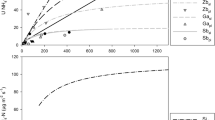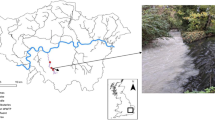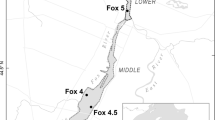Abstract
The reaeration coefficient (Ka20) is one of the main indicators of dissolved O2 movement to and from aquatic systems via the atmosphere. Direct gas tracer measurements, physical models, and models of O2 dynamics have been used for Ka20 estimation, especially in temperate aquatic ecosystems, with fewer examples in their tropical counterparts. Here we investigate a less commonly employed soluble floating probe (SFP) method, based on the dissolution rate of a soluble solid (VS20) as an auxiliary variable for Ka20 estimation. Our objectives were to test the SFP method for estimating Ka20, validate such estimates through the traditional gas tracer method, and develop empirical models for Ka20 prediction using VS20 and additional physical variables. Five reaches (with lengths from 20 to 250 m) of four tropical headwater streams were selected, and their main physical, hydrological, and hydraulic variables were measured in eight sampling periods. The gas tracer (using NaCl and SF6 tracers) and the SFP (spherical format made with oxalic acid dihydrate) methods were carried out in each reach. The Ka20 values ranged from 16.94 to 373.79 days− 1 and the VS20 ranged from 0.079 to 0.778 mm min− 1. We observed a significant linear relationship between Ka20 and VS20. The best model (R2 = 0.78) combined the variables depth, Froude number, and VS20. Our study highlighted that models developed for temperate aquatic systems can underestimate Ka20 in tropical streams, bringing uncertainties for modeling metabolic rates, self-depuration capacity, or any other processes that depend on reaeration.





Similar content being viewed by others
References
Abu Hanipah, A. H., & Guo, Z. R. (2019). Reaeration caused by intense boat traffic. Asian Journal of Water, Environment and Pollution, 16(1), 15–24. https://doi.org/10.3233/AJW190003.
Agunwamba, J. C., Maduka, C. N., & Ofosaren, A. M. (2006). Analysis of pollution status of Amadi Creek and its management. Journal of Water Supply: Research and Technology - AQUA, 55(6), 427–435. https://doi.org/10.2166/aqua.2006.036.
Alonso, C. V., McHenry, J. R., & Hong, J. C. S. (1975). The influence of suspended sediments on the reaeration of uniforms streams. Water Research, 9, 695–700.
Ambrose, R. B., Wool, T. A., & Barnwell, T. O. (2009). Development of water quality modeling in the United States. Environmental Engineering Research, 14(4), 200–210. https://doi.org/10.4491/eer.2009.14.4.200.
Arora, S., & Keshari, A. K. (2017). Estimation of re-aeration coefficient using MLR for modelling water quality of rivers in urban environment. Groundwater for Sustainable Development, 7, 430–435. https://doi.org/10.1016/j.gsd.2017.11.006.
Baecheler, J. V., & Lazo, O. L. (1999). Evaluation of water quality modeling parameters: Reaeration coefficient. In IAHR Congress.
Bansal, M. K. (1973). Atmospheric reaeration in natural streams. Water Research, 7, 769–782.
Barros, F. M., Martinez, M. A., Matos, A. T., Cecon, P. R., & Moreira, D. A. (2011). Oxygen balance of the Turvo Sujo river site at different periods of the year. Engenharia na Agricultura, 19(1), 72–80.
Belanger, T. V., Meyer, J. A., von Canal, M. G., & Desik, M. V. (1999). A simple field technique for accurate reaeration estimates in aquatic systems. Lake and Reservoir Management, 15(3), 185–199. https://doi.org/10.1080/07438149909354116.
Bennett, J. P., & Rathbun, R. E. (1972). Reaeration in open-channel flow. Washington: Geological Survey Professional Paper.
Benson, A., Zane, M., Becker, T. E., Visser, A., Uriostegui, S. H., DeRubeis, E., et al. (2014). Quantifying reaeration rates in alpine streams using deliberate gas tracer experiments. Water, 6(4), 1013–1027. https://doi.org/10.3390/w6041013.
Bicudo, J. R., & James, A. (1989). Measurement of reaeration in streams: Comparison of techniques. Journal of Environmental Engineering, 115(5), 992–1010.
Bullister, J. L., Wisegarver, D. P., & Menzia, F. A. (2002). The solubility of sulfur hexafluoride in water and seawater. Deep-Sea Research Part I: Oceanographic Research Papers, 49(1), 175–187. https://doi.org/10.1016/S0967-0637(01)00051-6.
Cadwallader, T. T., & MsDonel, A. J. (1969). A multivariate analysis of reaeration data. Water Research, 3, 731–742.
Canale, R. P., Owens, E. M., Auer, M. T., & Effler, S. W. (1995). Validation of water-quality model for Seneca River, N.Y. Journal of Water Resources Planning and Management, 121(3), 241–250. https://doi.org/10.1061/(ASCE)0733-9496(1995)121:3(241).
Chapra, S. C. (1997). Surface water quality modeling (1st ed.). McGraw-Hill.
Churchill, W. E., Elmore, H. L., & Buckingham, R. A. (1962). Prediction of stream reaeration rates. Journal of Sanitary Engineering Division, 88(4), 1–46.
Costa, O. S. (1999). Contribuição à metodologia para determinação indireta do coeficiente de reaeração dos escoamentos naturais de água com emprego do método da sonda solúvel. PhD thesis. University of São Paulo. São Carlos. Brazil.
Costa, D. J. L., Gonçalves, J. C. S. I., Porto, R. M., & Giorgetti, M. F. (2015). Semi-empirical model for obtaining the coefficient of surface water reoxygenation in hydraulic channels. Revista Brasileira de Recursos Hídricos, 20(1), 16–23.
Cox, B. A. (2003). A review of dissolved oxygen modelling techniques for lowland rivers. The Science of the Total Environment, 314–316(03), 303–334. https://doi.org/10.1016/S0048-9697(03)00062-7.
Demars, B. O. L., Thompson, J., & Manson, J. R. (2015). Stream metabolism and the open diel oxygen method: Principles, practice, and perspectives. Limnology and Oceanography: Methods, 13(7), 356–374. https://doi.org/10.1002/lom3.10030.
Elmore, H. L., & West, W. F. (1961). Effect of water temperature on stream reaeration: Thirty-first progress report by committee on sanitary engineering division. Journal of Sanitary Engineering Division, 87(6), 59–72.
Feng, J., Li, R., MA, Q., & Wang, L. (2014). Experimental and field study on dissipation coefficient of supersaturated total dissolved gas. Journal of Central South University, 21, 1995–2003. https://doi.org/10.1007/s11771.
Ferreira, M. S., Oliveira, R. V., Urzêdo, L. E. S., Lopes Júnior, G. B., & Gonçalves, J. C. S. I. (2018). Estimating the mass transfer coefficient using the floating soluble probes technique: A laboratory study. Engenharia Sanitária e Ambiental, 24(2), 391–402. https://doi.org/10.1590/s1413-41522019173205.
Fischer, H. B., List, E. J., Koh, R. C. Y., Imberger, J., & Brooks, N. H. (1979). Mixing in inland and coastal waters (2nd ed.). San Diego: Academic Press.
Giorgetti, M. F., & Giansanti, A. E. (1983). Avaliação do nível de turbulência em águas correntes e sua correlação com o coeficiente de reaeração superficial. Camboriú: Anais do XII Congresso da ABES.
Giorgetti, M. F., & Schulz, H. E. (1990). Sobre o método da sonda solúvel flutuante para a determinação indireta do coeficiente de reoxigenação superficial. Itapema: Anais do III Encontro Nacional de Ciências Térmicas.
Gonçalves, J. C. S. I., Silveira, A., Lopes Júnior, G. B., Luz, M. S., & Simões, A. L. A. (2017). Reaeration coefficient estimate: New parameter for predictive equations. Water, Air, & Soil Pollution, 228(8), 307. https://doi.org/10.1007/s11270-017-3491-5.
Grant, R. S. (1976). Reaeration-coefficient measurements of 10 small streams in Wisconsin using radioactive tracers : With a section on the energy-dissipation model. https://doi.org/10.3133/wri7696.
Gualtieri, C., & Gualtieri, P. (2004). Turbulence-based models for gas transfer analysis with channel shape factor influence. Environmental Fluid Mechanics, 4, 249–271. https://doi.org/10.1023/B:EFMC.0000024221.82818.70.
Gualtieri, C., Gualtieri, P., & Doria, G. P. (2000). Discussion on Melching and Flores (1999): Reaeration equations Derived from U.S. Geological Survey database. Journal of Environmental Engineering, 126(12), 1159–1160. https://doi.org/10.1061/(ASCE)0733-9372(2000)126:12(1159).
Gualtieri, C., Gualtieri, P., & Doria, G. P. (2002). Dimensional analysis of reaeration rate in streams. Journal of Environmental Engineering, 128(1), 12–18. https://doi.org/10.1061/?ASCE?0733-9372?2002?128:1?12?CE.
Haider, H., Ali, W., & Haydar, S. (2013). Evaluation of various relationships of reaeration rate coefficient for modeling dissolved oxygen in a river with extreme flow variations in Pakistan. Hydrological Processes, 27(26), 3949–3963. https://doi.org/10.1002/hyp.9528.
Hair Jr., J. F., Black, W. C., Babin, B. J., & Anderson, R. E. (2014). Multiple Regression Analysis. In Multivariate Data Analysis (7th ed., pp. 151–230). Harlow: Pearson Prentice Hall. https://doi.org/10.1007/978-3-319-01517-0_3.
Hall, R. O., & Hotchkiss, E. R. (2017). Stream Metabolism. Methods in Stream Ecology: Third Edition (Vol. 2). Elsevier Inc. https://doi.org/10.1016/B978-0-12-813047-6.00012-7.
Herlina, H., & Jirka, G. H. (2008). Experiments on gas transfer at the air-water interface induced by oscillating grid turbulence. Journal of Fluid Mechanics, 594, 183–208. https://doi.org/10.1017/S0022112007008968.
Howard, E. M., Forbrich, I., Giblin, A. E., Lott, D. E., Cahill, K. L., & Stanley, R. H. R. (2018). Using noble gases to compare parameterizations of air-water gas exchange and to constrain oxygen losses by ebullition in a shallow aquatic environment. Journal of Geophysical Research: Biogeosciences, 123(9), 2711–2726. https://doi.org/10.1029/2018JG004441.
Huisman, J. L., Weber, N., & Gujer, W. (2004). Reaeration in sewers. Water Research, 38(5), 1089–1100. https://doi.org/10.1016/j.watres.2003.11.025.
Isaacs, W. P., & Gaudy, A. F. (1968). Atmospheric oxygenation in a simulated stream. Journal of the Sanitary Engineering Division, 94(SA2), 319–344.
Jamieson, T. S., Schiff, S. L., & Taylor, W. D. (2013). Using stable isotopes of dissolved oxygen for the determination of gas exchange in the Grand River, Ontario, Canada. Water Research, 47(2), 781–790. https://doi.org/10.1016/j.watres.2012.11.001.
Jha, R., Ojha, C. S. P., & Bhatia, K. K. S. (2001). Refinement a predictive reaeration equations for a typical Indian river. Hydrological Processes, 15(6), 1047–1060. https://doi.org/10.1002/hyp.177.
Jha, R., Ojha, C. S. P., & Bhatia, K. K. S. (2004). A supplementary approach for estimating reaeration rate coefficients. Hydrological Processes, 18(1), 65–79. https://doi.org/10.1002/hyp.1312.
Jin, H. S., White, D. S., Ramsey, J. B., & Kipphut, G. W. (2012). Mixed tracer injection method to measure reaeration coefficients in small streams. Water, Air, and Soil Pollution, 223(8), 5297–5306. https://doi.org/10.1007/s11270-012-1280-8.
Kalburgi, P. B., Jha, R., Ojha, C. S. P., & Deshannavar, U. B. (2015). Evaluation of re-aeration equations for river Ghataprabha, Karnataka, India and development of refined equation. Environmental Technology, 36(1), 79–85. https://doi.org/10.1080/09593330.2014.937770.
Knapp, J. L. A., Osenbrück, K., & Cirpka, O. A. (2015). Impact of non-idealities in gas-tracer tests on the estimation of reaeration, respiration, and photosynthesis rates in streams. Water Research, 83, 205–216. https://doi.org/10.1016/j.watres.2015.06.032.
Krenkel, P. A., & Orlob, G. T. (1962). Turbulent diffusion and the reaeration rate coefficient. Journal of the Sanitary Engineering Division, 88(2), 53–116.
Langbein, W. B., & Durum, W. H. (1967). The aeration capacity of streams. Washington. https://doi.org/10.3133/cir542.
Lau, Y. L. (1972). Prediction equations for reaeration in open channel flow. Journal of Sanitary Engineering Division, 98(6), 1063–1068.
Lorke, A., Bodmer, P., Koca, K., & Noss, C. (2019). Hydrodynamic control of gas-exchange velocity in small streams. EarthArXiv. https://doi.org/10.31223/osf.io/8u6vc.
Maradei, G., Veltri, P., Morosini, A. F., & Verbeni, B. (2015). Laboratory study on the open channel flow reaeration: A dimensional approach. Urban Water Journal, 12(4), 295–304. https://doi.org/10.1080/1573062X.2014.896930.
Martin, N., McEachern, P., Yu, T., & Zhu, D. Z. (2013). Model development for prediction and mitigation of dissolved oxygen sags in the Athabasca River, Canada. Science of the Total Environment, 443, 403–412. https://doi.org/10.1016/j.scitotenv.2012.10.030.
Melching, C. S., & Flores, H. E. (1999). Reaeration equations derived from U.S. Geological Survey database. Journal of Environmental Engineering, 125(5), 407–414. https://doi.org/10.1061/(ASCE)0733-9372(1999)125:5(407).
Moog, D., & Jirka, G. (1998). Analysis of reaeration equations using mean multipicative error. Journal of Environmental Engineering, 124(2), 104–110.
Negulescu, M., & Rojanski, V. (1969). Recent research to determine reaeration coefficient. Water Resources, 3, 189–202.
Nuruzzaman, M., Al-Mamun, A., Salleh, M., & Bin, N. (2018). A modified laboratory approach to determine reaeration rate for river water. Arabian Journal for Science and Engineering, 43(4), 2037–2051. https://doi.org/10.1007/s13369-017-2897-0.
O’Connor, D. J., & Dobbins, W. E. (1958). Mechanism of reaeration in natural streams. Transaction of the American Society of Civil Engineers, 123(1), 641–666.
Omole, D. O., & Longe, E. O. (2012). Re-aeration coefficient modeling: A case study of river Atuwara in Nigeria. Research Journal of Applied Sciences, Engineering and Technology, 4(10), 1237–1243.
Owens, S., Edwards, R. W., & Gibbs, J. W. (1964). Some reaeration studies in streams. International Journal of Air and Water Pollution, 8(819), 469–486.
Padden, T. J., & Gloyna, E. F. (1972). Simulation of stream processes in a model river. Austin: Texas.
Palumbo, J. E., & Brown, L. C. (2013). Assessing the performance of reaeration prediction equations. Journal of Environmental Engineering, 140(3), 04013013. https://doi.org/10.1061/(asce)ee.1943-7870.0000799.
Parkurst, J., & Pomeroy, R. D. (1972). Oxygen absorption in streams. Journal of the Sanitary Engineering Division, 98(1), 101–124.
Parra, B. G., Rojas, L. E. P., Barrios, M., & Estrada, J. C. M. (2016). Uncertainty of discharge estimation in high-grade Andean streams. Flow Measurement and Instrumentation, 48, 42–50. https://doi.org/10.1016/j.flowmeasinst.2016.02.005.
Queiroz, F. M., Matos, A. T., & von Sperling, M. (2015). Estimation of reaeration coefficients of water in shallow moving-bed channel. Engenharia Sanitária e Ambiental, 20(1), 79–88. https://doi.org/10.1590/S1413-41522015020000113819.
Raymond, P. A., Zappa, C. J., Butman, D., Bott, T. L., Potter, J., Mulholland, P., et al. (2012). Scaling the gas transfer velocity and hydraulic geometry in streams and small rivers. Limnology and Oceanography: Fluids and Environments, 2(1), 41–53. https://doi.org/10.1215/21573689-1597669.
Riley, A. J., & Dodds, W. K. (2013). Whole-stream metabolism: Strategies for measuring and modeling diel trends of dissolved oxygen. Freshwater Science, 32(1), 56–69. https://doi.org/10.1899/12-058.1.
Rodrigues, I. C. (1996). Determinação do coeficiente de reaeração superficial de um corpo d’água com o uso de sondas solúveis esféricas. PhD thesis. University of São Paulo. São Carlos. Brazil.
Saltarelli, W. A., Dodds, W. K., Tromboni, F., Calijuri, M. C., Neres-lima, V., Jordão, C. E., & Cunha, D. G. F. (2018). Variation of stream metabolism along a tropical environmental gradient. Journal of Limnology, 73(3). https://doi.org/10.4081/jlimnol.2018.
Schulz, H. E. (1989). Investigação do mecanismo de reaeração da água em escoamento e sua correlação com o nível de turbulência junto a superfície. PhD thesis. University of São Paulo. São Carlos. Brazil.
Smith, R., Kaushal, S., Beaulieu, J., Pennino, M., & Welty, C. (2017). Influence of infrastructure on water quality and greenhouse gas dynamics in urban streams. Biogeosciences, 14, 2831–2849. https://doi.org/10.5194/bg-2016-380.
Soares, P. A., Faht, G., Pinheiro, A., da Silva, M. R., & Zucco, E. (2013). Determination of reaeration-rate coefficient by modified tracer gas technique. Hydrological Processes, 27(19), 2710–2720. https://doi.org/10.1002/hyp.9371.
Streeter, H. W., & Phelps, B. (1925). A study of the pollution and natural purification of the Illunois River. I. Surveys and laboratory studies. Public health bulletin, 146. https://doi.org/10.1002/ange.19290420217.
Thackston, E. L., & Dawson, J. W. (2001). Recalibration of a reaeration equation. Journal of Environmental Engineering, 127(4), 317–321.
Thackston, E. L., & Krenkel, P. A. (1969). Reaeration prediction in natural streams. Journal of Sanitary Engineering Division, 95(SA1), 65–94.
Thene, J. R., & Gulliver, J. S. (1990). Gas-transfer measurements using headspace analysis of propane. Journal of Environmental Engineering, 116(6), 1107–1124.
Thyssen, N., Erlandsen, M., Jeppesen, E., & Ursin, C. (1987). Reaeration of oxygen in shallow, macrophyte rich streams: I – Determination of the reaeration rate coefficient. Internationale Revue der gesamten Hydrobiologie und Hydrographie, 72(4), 405–429. https://doi.org/10.1002/iroh.19870720403.
Tromboni, F., Dodds, W. K., Neres-Lima, V., Zandona, E., & Moulton, T. P. (2017). Heterogeneity and scaling of photosynthesis, respiration, and nitrogen uptake in three Atlantic rainforest streams. Ecosphere, 8(9), 1–19. https://doi.org/10.1002/ecs2.1959.
Tsivoglou, E. C., & Neal, L. A. (1976). Tracer measurement of reaeration: III. Predicting the reaeration capacity of inland streams. Water Pollution Control Federation, 48(12), 2669–2689. https://doi.org/10.2307/25040082.
Tsivoglou, E. C., & Wallace, J. R. (1972). Characterization of stream reaeration capacity. Whashington.
Tyroller, L., Rousseau, D. P. L., Santa, S., & García, J. (2010). Application of the gas tracer method for measuring oxygen transfer rates in subsurface flow constructed wetlands. Water Research, 44(14), 4217–4225. https://doi.org/10.1016/j.watres.2010.05.027.
Webster, J. R., & Valett, H. M. (2007). Solute dynamics. In Methods in stream ecology (2nd ed., pp. 169–185). Academic Press. https://doi.org/10.1016/B978-012332908-0.50010-3.
Williams, R. J., & Boorman, D. B. (2012). Modelling in-stream temperature and dissolved oxygen at sub-daily time steps: An application to the river Kennet, UK. Science of the Total Environment, 423, 104–110. https://doi.org/10.1016/j.scitotenv.2012.01.054.
Zuur, A. F., Ieno, E. N., & Elphick, C. S. (2010). A protocol for data exploration to avoid common statistical problems. Methods in Ecology and Evolution, 1(1), 3–14. https://doi.org/10.1111/j.2041-210x.2009.00001.x.
Acknowledgments
The authors were supported by the Fundação de Amparo à Pesquisa do Estado de São Paulo (FAPESP; Process number: 2016/14176-1) and Conselho Nacional de Desenvolvimento Científico e Tecnológico (CNPq; Process numbers: 131505/2016-5; 300899/2016-5). The authors thank W.A. Saltarelli, N.R. Finkler and A.G. Cavallini for the valuable help in the fieldwork. Anonymous reviewers provided quite valuable comments for improving this manuscript.
Author information
Authors and Affiliations
Corresponding author
Additional information
Publisher’s Note
Springer Nature remains neutral with regard to jurisdictional claims in published maps and institutional affiliations.
Electronic supplementary material
ESM 1
(DOCX 39 kb)
Rights and permissions
About this article
Cite this article
de Souza Ferreira, M., de Campos Jordão, C.E.K.M.A., de Souza Inácio Gonçalves, J.C. et al. Surface Reaeration in Tropical Headwater Streams: the Dissolution Rate of a Soluble Floating Probe as a New Variable for Reaeration Coefficient Prediction. Water Air Soil Pollut 231, 58 (2020). https://doi.org/10.1007/s11270-019-4391-7
Received:
Accepted:
Published:
DOI: https://doi.org/10.1007/s11270-019-4391-7




